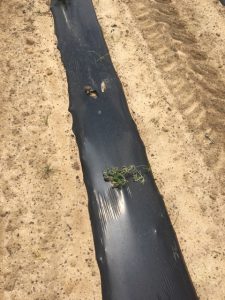Fusarium wilt of watermelon is a devastating problem for watermelon growers here in Turner County, and surrounding counties such as Crisp, Tift, Wilcox, and Worth. Fusarium has made its presence known over the last two weeks, with severe infestations showing up this week for sure. I would like to share some quick points with you to keep you informed with the proper information about fusarium wilt.
5 Unshakable Facts of Fusarium Wilt of Watermelon
- Fusarium Wilt of Watermelon is caused by the fungal pathogen fusarium oxysporum niviem (FON)

- Fusarium Wilt of Watermelon (FON) will NOT infect any other crop other than watermelon alone (This means it will not go to cantaloupe, cotton, tomato….)
- FON is a consistent problem in watermelon due to poor rotations.
- FON is soil borne and can persist for up to 16 years or more in some studies.
- FON prefers air temperatures of 77-80 Degrees F. Activity decreases at temperatures above the ones mentioned.
4 Ways to Identify Fusarium Wilt of Watermelon
- Individual runners on a plant will start to wilt. Leaves will lose turgor.
- If the stem is sliced long ways, discoloration may be seen in the vascular system.
- Plants with FON may occur in groups in the field.
- Tip, even though infection occurs in cooler temperatures, warmer temperatures may stress the vascular system and make the symptoms more apparent.
3 Tips for Controlling Fusarium Wilt of Watermelon
- Currently proline at transplant is the only recommendation we have and there is sufficient data that suggest it be used in any situation where melon rotation is tight or FON has occurred in the past.
- UGA is currently researching chloropicrin for control of FON.
- Rotation and planting date can also affect incidence, however, these may not be viable options in some cases.
Need-to-know Information on Races of Fusarium Wilt of Watermelon
- There are four races of FON that can affect watermelon. Race 0, Race 1, Race 2, and Race 3.
- Seedless melons can be resistant to Races 0 and 1.
- Pollinators (seeded melons) can have resistance to races 0-2.
- There is no resistance to Race 3.
- Race 3 has been identified in Georgia.
3 things that can be mistaken for fusarium
- Other soil borne diseases such as pythium or rhizoctonia
- Plant stem breaking off
- feeding injury from soil borne pest on to stem
For more information, please see view the link below that contains the latest publication from UGA on fusarium wilt.
https://secure.caes.uga.edu/extension/publications/files/pdf/B%201485_1.PDF